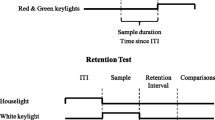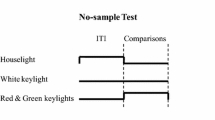Abstract
In experiment 1, pigeons were trained to match temporal (2, 8, and 10 s of houselight) and location (feeder light, left key, center key illumination) samples to color comparison stimuli. Red choices were correct following the 2-s and feeder light, orange choices were correct following the 8-s and center key, and green choices were correct following the 10-s and left key. Samples that were harder to discriminate (8- vs 10-s, and left vs center key) were mapped onto comparisons that were easy to discriminate (orange vs green), while samples that were easier to discriminate (2- vs 8-s, and feeder light vs left key) were mapped onto comparisons that were hard to discriminate(red vs orange). The pattern of errors for temporal and location samples indicated that these samples were not represented by a common code even though they were associated with the same comparison stimuli. In experiment 2, the same pigeons were trained with visual samples in which samples that were hard to discriminate (triangle vs circle) were mapped onto comparisons that were easy to discriminate (orange vs green), while samples that were easy to discriminate(plus vs triangle) were mapped onto comparisons that were hard to discriminate (red vs orange). Following acquisition of the visual discrimination, the temporal samples were re-introduced and many-to-one training was continued. During delay testing, the pattern of errors for temporal and visual samples was equivalent and consistent with the hypothesis that visual samples were being coded in terms of the duration appropriate for the temporal sample with which it shared a common comparison response. Data from no-sample test sessions ruled out a simple response bias explanation of the data. The properties of common codes for temporal and nontemporal events can be somewhat flexible and more complicated than previously envisaged.
Similar content being viewed by others
Author information
Authors and Affiliations
Additional information
Received: 21 January 1998 / Accepted after revision: 5 April 1998
Rights and permissions
About this article
Cite this article
Santi, A., Stanford, L. & Symons, J. An analysis of confusion errors in many-to-one matching with temporal and nontemporal samples. Anim Cogn 1, 37–46 (1998). https://doi.org/10.1007/s100710050005
Issue Date:
DOI: https://doi.org/10.1007/s100710050005




